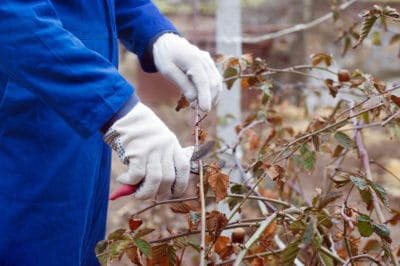Why Prune?
Blackberries that go too long without pruning eventually engulf their surroundings. Unless you stop them, their new shoots, or suckers, will invade other parts your garden or yard. And post-harvest pruning is essential for disease control.
Before You Begin
Nearly all thornless blackberry cultivars fruit on their second-year floricanes between early and late summer. Two exceptions are ‘Prime-Ark Freedom” and ‘Prime-Ark Traveler.’ Their first-year primocanes fruit in fall and again as floricanes the following summer.
To prune correctly, you need to know the differences between primocanes and floricanes:
- Primocanes are green, thick and somewhat pliable. Floricanes are grayish-brown, woody and somewhat stiff.
- Floricanes’ white spring flowers give way to green berries that eventually ripen to black. Most primocanes don’t bloom or fruit.
- Floricane leaves are closer together than primocanes’.
- Floricane leaves have three leaflets. Primocane leaves have five.
Things You’ll Need
A safe and thorough pruning session requires:
- 70-percent isopropyl rubbing alcohol
- Bucket or container deep enough to hold your pruning tools
- Roll of clean paper towels
- Sharp pruning shears
- Sharp branch loppers
- Biodegradable yard waste bags
Before starting, fill your bucket or container with enough rubbing alcohol to cover the tool blades. Wipe as much dirt and debris off the tools as possible. Then soak them in the alcohol for five minutes and dry them with clean paper towels. Now you can be confident they won’t transmit disease to your blackberries.
Pruning Schedule
When your blackberries’ primocanes reach 3 feet high in summer, prune off their tips. They’ll send out side shoots, or laterals, that result in a heavier harvest the following summer.
After harvesting your ripe berries, prune the old floricanes back to the soil line. By this time, you may need the branch loppers to do the job. Bag and dispose of the pruned material in case it’s harboring pests or disease.
In late winter or very early spring, prune out damaged, diseased or broken canes from each plant. Leave four to six of the most vigorous. This is also the time to cut all the lateral branches back to 12 inches. You’ll be rewarded with much bigger berries!
